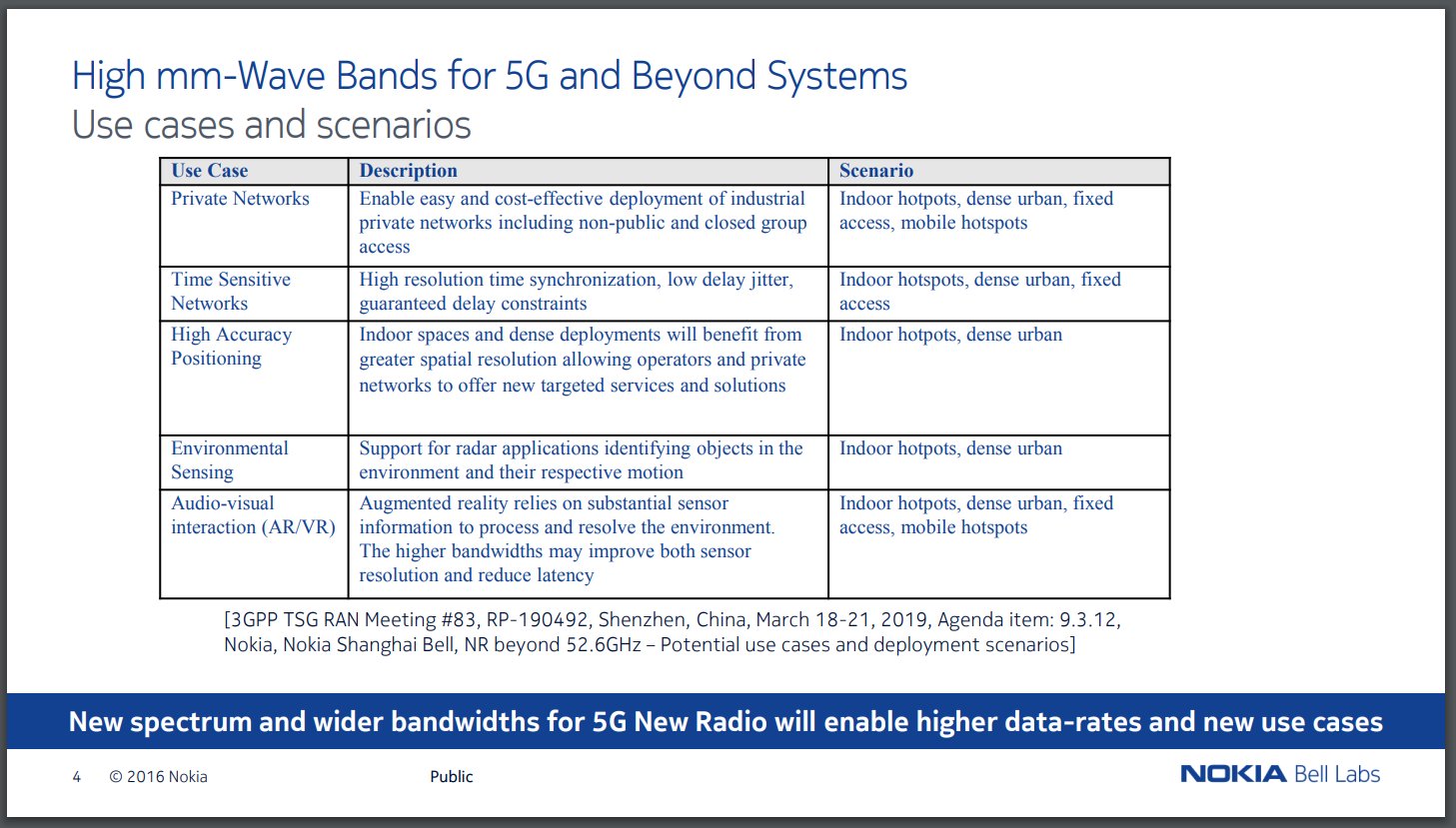The relatively underutilized
millimeter-wave (mmWave) spectrum offers excellent opportunities to
provide high speed data rate, low latency, and high capacity due to the
enormous amount of available contiguous bandwidth. However, operation on
bands in frequencies above 52.6GHz will be limited by the performance
of devices, for example, poor power amplifier (PA) efficiency and larger
phase noise impairment, the increased front-end insertion loss together
with the low noise amplifier (LNA) and analog-to-digital converter
(ADC) noise. In addition, bands in frequencies above 52.6GHz have high
propagation and penetration losses challenge. Even so, various use cases
are envisioned for NR operating in frequencies between 52.6GHz and
114.25GHz. Some of the use cases are illustrated in Figure 5.1-1 and
following section provide detailed description of the uses cases. It
should be noted that there is not a 1-to-1 mapping of use cases and
wireless interfaces, e.g. Uu, slidelink, etc. Various wireless
interfaces could be applicable to various uses cases described.
Within the range 52.6 to 116 GHz, the frequency bands 66-76 GHz (including 66-71 and 71-76 GHz) and 81-86 GHz are being studied under WRC-19 Agenda Item 1.13 for potential IMT identification. Results of sharing and compatibility studies, potential technical and regulatory conditions are included in Draft CPM Report, and the final decisions are to be made in WRC-19 with respect to IMT identification or no IMT identification, along with the corresponding technical and regulatory conditions.
For 66-71 GHz, Studies were carried out for the ISS, MSS (Earth-to-space) indicating that sharing is feasible, with a need for separation distance in the order of few kilometers for the case of MSS (space-to-Earth). The need for studies addressing interference from IMT towards RNS is still under debate. Thus, final conclusions in the regulatory and technical conditions for this band cannot be drawn.
For 71-76 GHz, studies were carried out for the FS, RLS and FSS (space-to-Earth) indicating that sharing with FS and FSS is feasible. However, additional limits of the IMT BS and UE unwanted emissions is needed to protect RLS in the adjacent frequency band 76-81 GHz.
For 81-86 GHz, studies were carried out for the FS, FSS (Earth-to-space), RAS (in band and adjacent band), EESS (passive) and RLS. Studies are not needed for the SRS (passive), as this service is dealing with sensors around other planets and no interference issue is expected. Studies were also not carried out for the MSS. The results of those studies indicate that sharing with FS, FSS and RAS (in band and adjacent band) is feasible. Notice that additional limits of the IMT BS and UE unwanted emissions would be needed to ensure protection of EESS (passive) in the adjacent frequency band 76-81 GHz and RLS in the adjacent frequency band 86-82 GHz.
- High data rate eMBB
- Mobile data offloading
- Short-range high-data rate D2D communications
- Vertical industry factory application
- Broadband distribution network
- Integrated access backhaul (IAB)
- Factory automation/Industrial IoT (IIoT)
- Augmented reality/virtual reality headsets and other high-end wearables
- Intelligent Transport Systems (ITS) and V2X
- Data Center Inter-rack Connectivity
- Smart grid automation
- Radar/Positioning
- Private Networks
- Critical medical communication
Within the range 52.6 to 116 GHz, the frequency bands 66-76 GHz (including 66-71 and 71-76 GHz) and 81-86 GHz are being studied under WRC-19 Agenda Item 1.13 for potential IMT identification. Results of sharing and compatibility studies, potential technical and regulatory conditions are included in Draft CPM Report, and the final decisions are to be made in WRC-19 with respect to IMT identification or no IMT identification, along with the corresponding technical and regulatory conditions.
For 66-71 GHz, Studies were carried out for the ISS, MSS (Earth-to-space) indicating that sharing is feasible, with a need for separation distance in the order of few kilometers for the case of MSS (space-to-Earth). The need for studies addressing interference from IMT towards RNS is still under debate. Thus, final conclusions in the regulatory and technical conditions for this band cannot be drawn.
For 71-76 GHz, studies were carried out for the FS, RLS and FSS (space-to-Earth) indicating that sharing with FS and FSS is feasible. However, additional limits of the IMT BS and UE unwanted emissions is needed to protect RLS in the adjacent frequency band 76-81 GHz.
For 81-86 GHz, studies were carried out for the FS, FSS (Earth-to-space), RAS (in band and adjacent band), EESS (passive) and RLS. Studies are not needed for the SRS (passive), as this service is dealing with sensors around other planets and no interference issue is expected. Studies were also not carried out for the MSS. The results of those studies indicate that sharing with FS, FSS and RAS (in band and adjacent band) is feasible. Notice that additional limits of the IMT BS and UE unwanted emissions would be needed to ensure protection of EESS (passive) in the adjacent frequency band 76-81 GHz and RLS in the adjacent frequency band 86-82 GHz.





No comments:
Post a Comment